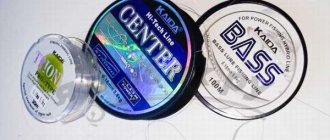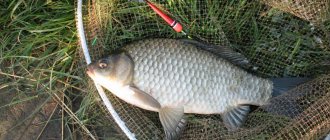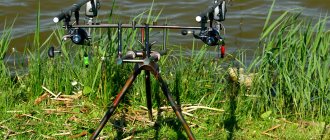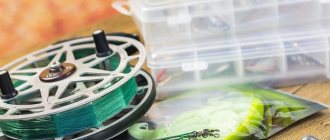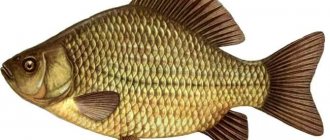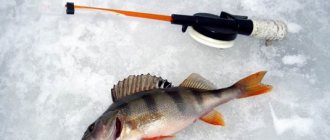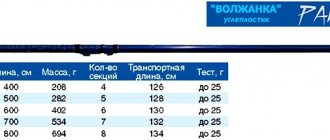How to choose a donk: rod parameters
Depending on what kind of fish you plan to catch, select the necessary spinning rod. For bream and roach, a fairly light, compact “stick” marked “light” is quite suitable. For catfish, you should choose a more powerful model, for example, “medium heavy” or “heavy”. A rod for catching predators should allow active fishing from long distances. If you follow these simple rules, the life of your rod will be much longer, and fishing will be a pleasure.
In some cases, you can do without a rod by using a “snack”. On such a bottom, the line is wound on a reel, and casting is done by hand. The disadvantage of this kind of fishing is the ability to fish at a distance of no more than fifty meters.
Other components
The fishing line for the donkey is taken strong, with maximum elongation; The cross section of the line depends on the casting distance. The fishing line for the donkey is monofilament or braided.
The reels included in the design of the donkey are a multiplier or an inertia-free reel, as desired. With a multiplier, fishing is quite simple. The second option is suitable for those who like to use electrified bite alarms. The capacity of the reel should be more than one hundred meters of fishing line.
Compactness and lightness are not so important in this case; Strength is much more important, since fishing with a donkey is carried out without frequent casting and retrieving, without holding the rod in your hands for a long time, but fishing for large fish is very much implied. Durability will be a prerequisite. The cheaper the coil, the faster it will fail.
Sinkers and hook
The donkey rig must include sinkers and at least one leash with hooks . Donka fishing is carried out using hundred-gram sinkers. It is important to remember: the more compact the heavy sinker, the less it will be carried away by the current.
Peaceful fish are caught with a bottom equipped with a feeder, from which the food is washed out. The leashes are secured to the fishing line with bends. The length of the leashes varies depending on the fish being caught. To catch predatory fish, take a longer leash.
Choosing a feeder rod and reel depending on fishing conditions
Today, the fishing tackle market is saturated with a huge number of feeder rods for every taste and color. All of them differ in certain parameters - length, test, structure, material from which they were made, purpose and especially important for a novice fisherman - price. After all, it will not be a secret that universal feeder rods (just like spinning rods and others) simply do not exist. And each rod is designed to best suit the specific conditions of its use.
In addition, as a result of competition between manufacturers, the market is also overcrowded with gear that is absolutely similar in purpose under different brands. But how does a beginner need to make a choice? And in practice, three main approaches to choosing a fishing rod (as well as reels, fishing lines, etc.) have emerged.
- Buy exactly the same as your friend’s, or choose based on his advice.
- Listen to the recommendations of the fishing store seller.
- Spend a lot of time to sift through the contents of all fishing sites and forums, re-read tons of fishing magazines and newspapers, find the necessary information bit by bit, and then, summarizing it, make your choice.
But it’s good if your friend or the salesperson in the store is an experienced feeder who has an idea of the features of using this equipment in practice and is well versed in the fishing market. And if not? And your friend also bought his fishing rod on the advice of his friend, and the seller in the store simply decided to sell you a stale or most expensive product? Of course, the third of the above methods is the most labor-intensive, but also effective, since you yourself can choose the right rod based on the analyzed information and clearly formulate the requirements for the rod, based on your specific fishing conditions.
A similar situation arises when choosing a coil. But if an inexperienced angler can somehow figure out the rods by studying the relevant publications, then with the choice of a reel things are more complicated - there is a rather large information gap: many articles and video reviews on the pages of websites or fishing magazines give a very poor description of the features of the reels that are suitable for feeder fishing, or even provide incorrect information, especially in advertising publications. And with fishing lines for the feeder, things are similar.
So, I repeat, in order to figure out what kind of feeder rod we need, as well as to select a suitable reel, first of all, we should clearly formulate the fishing conditions under which we are going to fish. And only after this we will be able to select a narrow circle of units suitable for us from the huge mass of hundreds and thousands of different rods and reels. Well, then everything will depend on the available budget, brand preferences, personal anthropometric indicators and aesthetic preferences.
So, when choosing the appropriate gear, you have to take into account the following fishing conditions:
- type of reservoir (it can be a small pond, lake, reservoir, river, canal, etc.) and its features (size, depth, bottom topography, presence of current);
— the nature of the shoreline of the reservoir (presence of trees, bushes, power lines overhead, etc.);
- the type and size of the fish we are aiming to catch in a given reservoir - say, bream - or roach, crucian carp - or carp, as well as the size of the trophy, meeting which is more or less real. For example, for catching roach in a reservoir, a rod that is much more gentle is suitable than for large carp at a paid rate;
— approximate number of fishing trips per season;
- type of main fishing line that we are going to use in our gear.
The first three conditions directly indicate the choice of specific technical parameters of any rod and reel, which we will discuss below, while the last two have their influence indirectly.
The essence of the penultimate condition is that when choosing gear, one must take into account the consistency of its operation.
It’s one thing when a person goes fishing 2-3 times a year - and the rest of the time the fishing rod collects dust in the closet. Then it is not necessary to concentrate on the top products of famous brands - they are not masterpieces, but quite good feeder rods are produced by others, including domestic companies, and their prices are very attractive in both the average and advanced categories. But if an angler spends every weekend and entire vacation on a river or lake, then using a professional feeder rod will be justified.
As for feeder reels, in such a situation, inexpensive products, even if they fully satisfy the needs of the fisherman, simply may not have the necessary performance resource for very frequent, long-term and “labor” fishing trips, and therefore these reels (or their individual elements) As a rule, they fail very quickly. Thus, taking into account the approximate number of fishing trips per season, it will not be difficult for us to distinguish the total mass of all existing fishing rods into two subgroups: top professional gear with a large margin of safety and wear resistance and not so expensive, but quite working analogues.
The last condition, I think, must also be taken into account. The type of main line - whether it is supposed to be braided or monofilament - is not directly related to the technical characteristics of rods and reels, but it indirectly affects the choice of specific gear, which we will discuss below.
Types of fishing rods
In addition to the classic donka and “zakidushka”, there are two more types of well-known donkas: elastic and ring.
- The elastic band is a young, but quite popular tackle. She throws herself into the water at the beginning of fishing only once. The elastic band is tied to a weighty load, after which fishing line and hooks are attached to it. The elastic band, stretching several times, allows the fisherman not to move the load from its place, choosing the fishing line to the hooks.
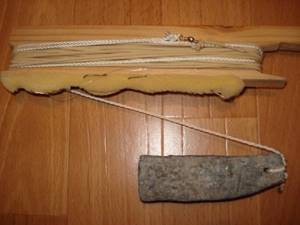
After the caught fish is removed from the line, the rubber band is slowly lowered back into the water, returning the hooks to their original place. At the end of fishing, the load is pulled out using a strong cord previously tied to it.
- The ringer got its name because of the sinker made in the shape of a ring. Fishing with such a bottom is carried out in a reservoir with flowing water, where a bag of bait is lowered on a strong cord - a feeder. A fishing line several meters long is dropped over the side of the boat. Leashes and hooks hang on the fishing line. A sinker is put on the cord and fishing line through the slot, sliding down to the feeder. The fishing line is submerged under water.
The current straightens the fishing line and hooks in the area where the bait, washed out of the feeding bag, is located. Sometimes the sinker, having put it on the cord, is connected to an additional leash tied to the fishing line, which makes it possible to eliminate snags on the feeder, as well as the interweaving of the cord and fishing line. To remove a caught fish, remove the fishing line with hooks and sinkers from the water, remove the fish and return everything to its original place.
Sinker for the “donkey”.
The weight of the sinker used is determined by the fishing conditions; it should be enough for a comfortable cast to the desired point, and also so that the entire equipment is not carried away by the current when fishing on the river. Weight can vary from 20 grams to 100-120 grams on rivers with strong currents.
An excellent example would be a diamond-type sinker. Such a load is cast in the shape of a diamond and has protruding spikes that act as lugs. When fishing in a current, the sinker sinks to the bottom and the protrusions go into the ground.
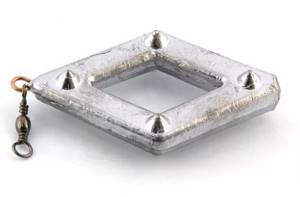
The “drop” type load will also work well. They are useful when fishing at long distances, as they provide long casting due to their streamlined shape.
Donka for fishing with your own hands: preparation
Making a donka with your own hands is not difficult. You will need rods, sinkers, fishing line, and several fishing hooks.
Particular attention must be paid to the choice of sinker. It all depends on:
- the fish they are going to catch;
- the presence or absence of current in a body of water;
- bottom structure - whether it is muddy or rocky.
The sinker can be attached to the end of the fishing line, placing the hooks and leashes slightly above it, or you can use the option with a sliding sinker, or you can tie it to an additional leash.
There should be two or three leashes, their length no more than fifty centimeters. A properly made donkey with three leashes will give you the opportunity to catch more fish than a donkey with four or five.
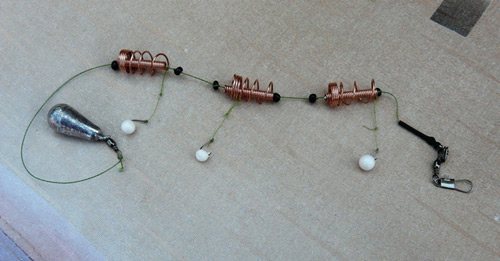
The hooks must be very sharp so that during passive fishing the fish themselves are caught on them. An ordinary bell is used as a signaling device, or you can simply monitor the vibrations of the rod tip.
To make a donk with your own hands, in addition to the equipment, you need to prepare a galvanized fence mesh, copper wire, lead for cable winding, an electric drill and a rivet gun.
How to do the job right
Stages of work on making a donk:
- A strip is cut out of the mesh, cut into several parts, and a feeder of the required shape is bent from them. The structure is fastened with wire staples.
- A weight is made from sheet lead that will hold the feeder in the water. The lead is folded several times, and a hole is drilled in the center with a drill.
- Using a rivet gun or simply a bolt and nut, the load is connected to the feeder.
Various designs of bottom gear from “old-fashioned” to “modern”.
An ordinary “grandfather’s” donka.
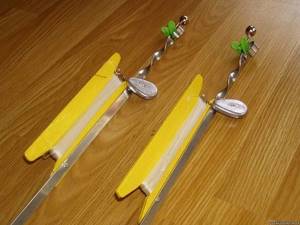
I talked about this interesting gear above; it is the simplest and easiest to implement and, most importantly, the cheapest to manufacture. Agree, you can cast the weight yourself, from recycled lead, cut the reel from any dense material (cardboard, plastic, whatever), regular monofilament fishing line is cheap and easily accessible, and you can also tie the leashes yourself. Catch it, I don’t want it!
“Donka” with a rubber shock absorber or “donka with an elastic band”.
Once upon a time, this modification to the gear revolutionized bottom fishing. I will tell you how this “legendary” tackle is made in another article, since it really deserves it, so to speak, for future generations. In the meantime, I’ll tell you why I consider her legendary. This modification made it possible to implement what is implemented in modern gear, such as a feeder or a “classic donkey”, namely:
- delivery of bait to the same fishing spot;
- the possibility of complementary feeding of the desired area;
- absolutely silent fishing.
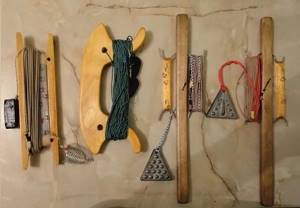
"Classic donka" or "skid".
You've probably seen this gear mentioned more than once. So, by classic bottom tackle I mean a “throwaway”, which I consider the progenitor of modern bottom tackle presented in any fishing store. In fact, it is no different from the usual one, only slightly modified for personal convenience.
To track the bite, as well as transfer the entire installation, they began to use a handle (or stick) in the shape of a regular fishing rod, pointed on the back side. Often the fishing rod was made of bamboo. Two staples in the shape of the letter “Z” at a distance of 20-25 cm from each other, bent from thick strong wire, were attached to this homemade fishing rod and filled with epoxy resin (optional). These staples served as a reel. At a distance of 10 cm from the free end of the fishing line, a loop for a bell was knitted (at that time there were no “bells on a clothespin”), and the free end itself was tied to the end of the rod.
The equipment was thrown into the water, and the pointed part of the rod was stuck into the ground at an angle of 45-60 degrees; when a bite occurred, the bell began to ring pleasantly!
Modern donka.
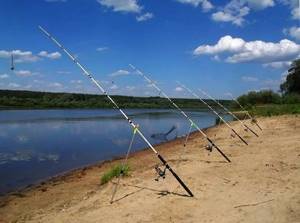
I once thought that modern bottom tackle was the best that could happen in this area of fishing, but then the so-called “English bottom” began to gain popularity. Nevertheless, now a huge number of fishermen are catching with this gear.
The use of a rod and an inertia-free reel made it possible not only to control the casting of equipment over a long distance, but also to significantly influence the hooking of fish and its landing. And the use of feeders in the equipment made it possible to lure fish to the fishing point and keep it there.
What does modern bottom tackle consist of?
Modern bottom tackle consists of:
- a special rod of medium length and quite durable, equipped with guides of medium diameter, as well as a reel seat;
- an inertia-free reel with the main line wound on a spool.
- equipment with a feeder and a leash.
This design is very similar to the “throwaway” one, only in it the reel was replaced with a reel with a spool, and rings were added. This made it possible to use the rod for casting equipment and fishing for fish.
"English Donka" or feeder.
Read about this interesting and increasingly popular gear here.
Choosing a fishing spot
The area of the reservoir for bottom fishing should be free of algae and snags. The most effective is considered to be spot fishing with bottom gear installed in places where fish approach. Places with trees, bushes hanging over the water, or snags sticking out of the water are suitable.
The weights are manually swung like a pendulum and casted. Immediately before casting, the fishing line from the reel of the required length is wound into neat rings and laid in such a way that when casting, the equipment removes the top ring. This will help prevent the line from getting tangled.
Tackle
Tactics determine the differences in equipment. The trend in donkeys is to increase the number of tackles on the shore, thrown at different points, as well as several hooks in each rig. The main difference between feeder fishing is tempo fishing. One tackle with one hook in the rig. The emphasis is on selecting equipment for the fish, actively catching it at a feeding point.
Differences between feeder and donkey:
- Donka is a simple spinning rod with which you can at least somehow cast the tackle. The feeder is a thin tool for making long and accurate casts. The rod, reel and main line are selected carefully. Article about feeder gear
- The feeder is equipped only with a spinning reel, with a gear ratio of approximately 5 to 1. You need a high-torque and reliable reel. Any cheap Chinese or inertial coils will work for donks.
- The feeder rod is of the plug type, with a flexible tip with a quiver tip for registering bites. On bottoms, the bite is determined by a bell or other signaling devices that complicate the equipment.
Bottom tackle is a general concept that includes both a feeder and a spinning rod. Feeder is the next step in the development of fishing art. Accordingly, this method of fishing forces the angler to think more carefully about equipment issues. Feeder tackle is a thin surgical instrument with many settings that allows you to find fish in unfavorable biting conditions. Article about types of bottom gear.

Equipment for modern donkey.
As a rule, the equipment in modern bottom gear consists of a feeder and a leader/leaders. There are quite a lot of options for making various installations, I will talk about some of them in the future.
The most popular is installation using a “spring feeder”. This montage was one of the first to appear, and even now some variations remain popular, for example, “crucian carp killer” or “carp killer.”
Also widely used are rigs using feeders, but more in feeder fishing.
